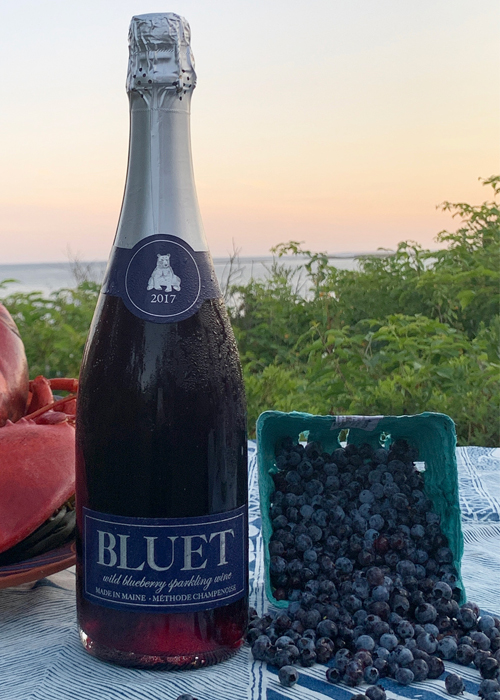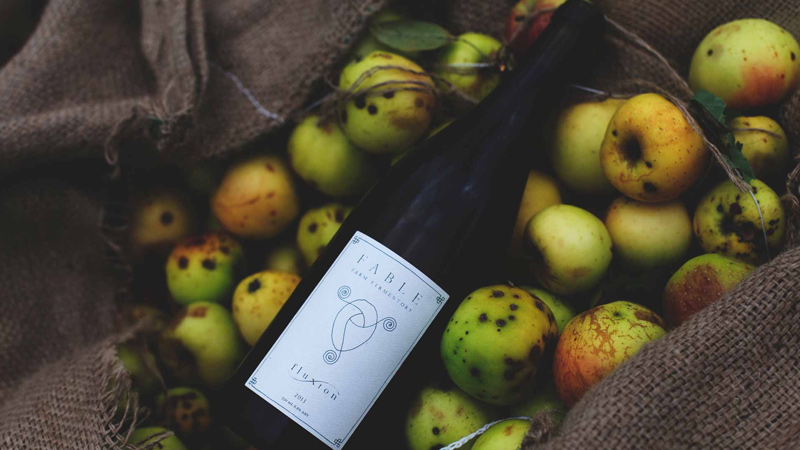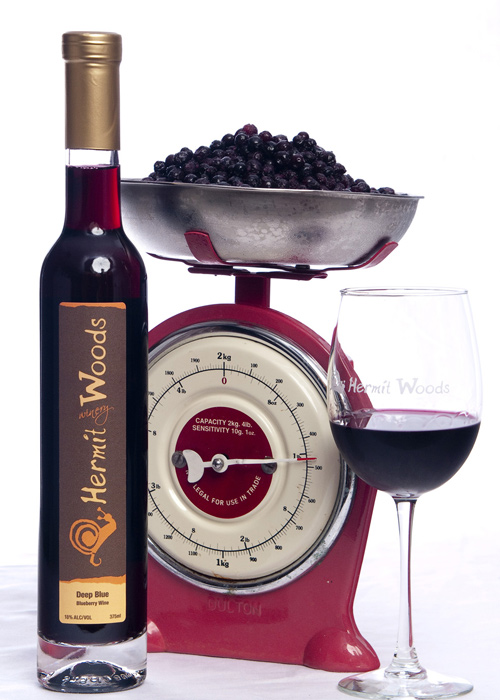Despite the grape being a fruit, the term “fruit wine” usually connotes a sweet beverage made from ingredients — blueberries, rhubarb, apples — more commonly baked than vinified. However, a crop of winemakers in the northeastern United States is taking local produce and crafting something more akin to vinous blends. While creating a delicious drink is the main intention, many have an underlying motive: to support local agriculture.
For winemaker Michael Terrien, co-founder of Obsidian Wine Company and owner of Terrien Wines in California, the seeds were sown at his wedding in Maine. While most of the food for the affair was sourced locally, the wine was not. This realization led him to Maine’s biggest crop: blueberries. However, the sugary styles normally associated with blueberry wines didn’t interest him, so he began experimenting with dry styles for his Bluet wines, created in partnership with his childhood friend Eric Martin.
Because blueberries are inherently high in acid but don’t have a lot of tannins, Terrien knew from the get-go that the wine would need to be sparkling in order to give it texture and the sensation of fullness. “We started with the premise of, ‘Let’s make it without having to add anything else,’” he says. “That meant it had to be bubbled.”
Bluet is made in both the Charmat method as well as méthode champenoise, the latter of which, Terrien says, gives the wine great aging potential due to the berries’ high levels of antioxidants. He takes what he calls a “blanc de noirs” approach, in which fruit is immediately pressed from the skins, fermented, and left to rest en tirage for six to nine months before disgorgement.
All hybrid bush blueberries grown throughout the world are derived from the genetic material of Maine’s state fruit. “So, this is the original blueberry,” Terrien says. His desire to preserve the fruit’s provenance means he doesn’t see sparkling blueberry wine as a novelty product; in fact, he thinks it could help bolster Maine’s struggling wild blueberry industry.

Small wild blueberry farmers make up 40 percent of Maine’s blueberry industry. These boutique producers, facing challenges such as competition from countries like Canada, have seen a 71 percent decline in value from 2011 to 2018, according to the United States Department of Agriculture (USDA). Terrien calculates that making blueberry wine in the equivalent amount of Cabernet Sauvignon grown in the Napa Valley — which accounts for only 4 percent of overall domestic wine production, despite its outsized reputation — would double the entire state’s blueberry crop by volume and enable Maine’s growers to reap better profits.
As part of his initiative, Terrien has been rallying friends and colleagues to start making blueberry sparkling wine and create a viable category. “It’s just the wrong path to try to say, ‘Hey, it’s like Pinot Noir, it’s like Cabernet,’” he says. “It is going to condemn the wine to comparison. But if you’re in your own category, which we are, then there is only the comparison to itself.” Bluet is distributed in several states on the East Coast as well as Southern California, and sold through the brand’s website.
Terrien’s first protégé is RAS Wines, set to release the inaugural vintage of its Arkadia sparkling blueberry wine in March 2021. Co-owner Joe Appel, along with partners Dan Roche and Emily Smith, took their learnings from Terrien, but they approach vinification slightly differently. They plan to do longer macerations — anywhere from two-and-a-half to four weeks — and will focus on a Pét-Nat style, where the wine won’t be disgorged after second fermentation. Unlike Terrien, they work with frozen fruit. “The freezing process makes the cell structure break down,” says Appel, “so it’s easier to ferment.”
Both Terrien and Appel are eager to learn more about terroir differences in blueberry fields as they work on future vintages. Terrien already sees different profiles in the fruit from his two major sources in the Blue Hill and Appleton Ridge regions, and is curious to see how different subspecies of berries, similar to vinifera clones, will portray themselves in wine form.

On New Hampshire’s Lake Winnipesaukee, Hermit Woods also looks to local produce for its wines, but puts the fruit in a familiar, vinous context. As co-owner Bob Manley puts it, it started with the question, “How can we craft a wine that’s familiar to us stylistically as opposed to the sweet wines made from local fruit?” The winery’s approach has taken — and still involves — intense trials. It’s not uncommon for winemaker Ken Hardcastle to make 100 micro-cuvées per year, studying everything from fruit choices to barrel aging to yeasts in a controlled, scientific manner.
The harvest basket of indigenous fruits available to Hermit Woods means less need for pesticides because plants are acclimated to the climate. Manley partners with growers who work fully organically or highly sustainably.
Common fruits like blackberries, raspberries, and blueberries go into cuvées, as do the lesser-known rose hips and elderberries. The winery also takes advantage of native berries like autumn berries, which, as an invasive species, can’t be planted. Instead, the team harvests existing bunches, which enhance the wine’s tannic structure.
Although Hardcastle experimented with wine grapes in the early 2000s, it became apparent to the Hermit Woods team that fruit wine would better serve the community. “Importing grapes from around the world is not a sustainable practice, so we didn’t want to engage in it,” says Manley. “That’s been an important aspect of everything we’ve done. We want to produce our wine from healthy fruit. We want to support local farmers. We want to put the money back into the community where we’re making the wine whenever possible.”
With a current annual production of 5,000 cases, Manley says they don’t want to grow any larger because they can’t scale and still be able to source locally. The winery sells directly to customers through the tasting room and via online sales, as well as through New Hampshire’s state-run liquor stores and a few local restaurants.
As with Hermit Woods, foraging plays a key role in sourcing fruit at Vermont’s Fable Farm Fermentory. Brothers Jon and Christopher Piana began fermentation experiments with the wild cider apples that grow in abundance throughout the area. Without any formal training, they approached the process “from an intuitive place,” says Jon Piana, “mostly learning through trial and error.” That includes eschewing the additions of yeast, sugar, and sulfur. What they found, he says, is that the juice “showed itself as a unique, dry, alpine white wine.”

But isn’t wine made from cider apples technically cider? Piana notes that although the term “wine” is printed on their labels, they intentionally use “wine” and “cider” interchangeably when talking about their products, almost as a way to break people’s conceptions of what cider — and even apple wine — can be. But at their core, they consider themselves winemakers.
While in the U.S., cider connotes a highly manipulated, sweet alcoholic beverage, “It is a very adulterated, artificially carbonated, commodity-of-scale type of thing,” Piana says, and has little relation to their methods or philosophy. “I’m really paying attention to the orchard and the place-based factors of the farming, the fermenting, the fruit, and the local yeast. And a lot of these things are what I think go into making good wine.” Even apple wine, normally a sweet concoction, bears no relation to Fable Farm’s bottlings.
Winemakers such as these are redefining the current perception of fruit wines. They’re showing that, with the right produce and the right techniques, fruit wines can be as dry and complex as their vinifera counterparts; and that by working with indigenous fruits and employing local labor, fruit wine producers can create supportive revenue streams for their communities.